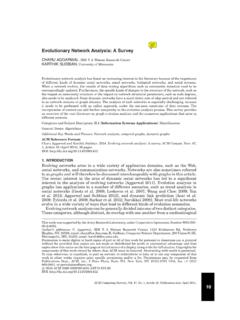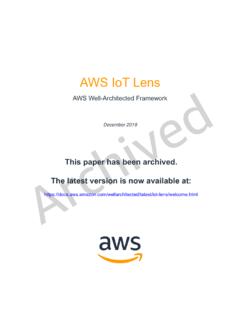Transcription of BUSINESS INTELLIGENCE AND ANALYTICS FROM BIG …
1 SPECIAL ISSUE: BUSINESS INTELLIGENCE RESEARCH. BUSINESS INTELLIGENCE AND ANALYTICS : FROM BIG DATA TO BIG IMPACT. Hsinchun Chen Eller College of Management, University of Arizona, Tucson, AZ 85721 Roger H. L. Chiang Carl H. Lindner College of BUSINESS , University of Cincinnati, Cincinnati, OH 45221-0211 Veda C. Storey J. Mack Robinson College of BUSINESS , Georgia State University, Atlanta, GA 30302-4015 BUSINESS INTELLIGENCE and ANALYTICS (BI&A) has emerged as an important area of study for both practitioners and researchers, reflecting the magnitude and impact of data-related problems to be solved in contemporary BUSINESS organizations. This introduction to the MIS Quarterly Special Issue on BUSINESS INTELLIGENCE Research first provides a framework that identifies the evolution, applications, and emerging research areas of BI&A.
2 BI&A , BI&A , and BI&A are defined and described in terms of their key characteristics and capabilities. Current research in BI&A is analyzed and challenges and opportunities associated with BI&A. research and education are identified. We also report a bibliometric study of critical BI&A publications, researchers, and research topics based on more than a decade of related academic and industry publications. Finally, the six articles that comprise this special issue are introduced and characterized in terms of the proposed BI&A research framework. Keywords: BUSINESS INTELLIGENCE and ANALYTICS , big data ANALYTICS , Web Introduction percent of companies with revenues exceeding $100 million were found to use some form of BUSINESS ANALYTICS . A report BUSINESS INTELLIGENCE and ANALYTICS (BI&A) and the related by the McKinsey Global Institute (Manyika et al.)
3 2011) pre- field of big data ANALYTICS have become increasingly important dicted that by 2018, the United States alone will face a short- in both the academic and the BUSINESS communities over the age of 140,000 to 190,000 people with deep analytical skills, past two decades. Industry studies have highlighted this as well as a shortfall of million data-savvy managers with significant development. For example, based on a survey of the know-how to analyze big data to make effective decisions. over 4,000 information technology (IT) professionals from 93. countries and 25 industries, the IBM Tech Trends Report Hal Varian, Chief Economist at Google and emeritus profes- (2011) identified BUSINESS ANALYTICS as one of the four major sor at the University of California, Berkeley, commented on technology trends in the 2010s. In a survey of the state of the emerging opportunities for IT professionals and students BUSINESS ANALYTICS by Bloomberg Businessweek (2011), 97 in data analysis as follows: MIS Quarterly Vol.
4 36 No. 4, pp. 1165-1188/December 2012 1165. Chen et : BUSINESS INTELLIGENCE Research So what's getting ubiquitous and cheap? Data. And storage, management, analysis, and visualization technol- what is complementary to data? Analysis. So my ogies. In this article we use BUSINESS INTELLIGENCE and ana- recommendation is to take lots of courses about how lytics (BI&A) as a unified term and treat big data ANALYTICS as to manipulate and analyze data: databases, machine a related field that offers new directions for BI&A research. learning, econometrics, statistics, visualization, and so BI&A The opportunities associated with data and analysis in dif- ferent organizations have helped generate significant interest As a data-centric approach, BI&A has its roots in the long- in BI&A, which is often referred to as the techniques, tech- standing database management field.
5 It relies heavily on nologies, systems, practices, methodologies, and applications various data collection, extraction, and analysis technologies that analyze critical BUSINESS data to help an enterprise better (Chaudhuri et al. 2011; Turban et al. 2008; Watson and understand its BUSINESS and market and make timely BUSINESS Wixom 2007). The BI&A technologies and applications decisions. In addition to the underlying data processing and currently adopted in industry can be considered as BI&A , analytical technologies, BI&A includes BUSINESS -centric where data are mostly structured, collected by companies practices and methodologies that can be applied to various through various legacy systems, and often stored in commer- high-impact applications such as e-commerce, market intelli- cial relational database management systems (RDBMS).
6 The gence, e-government, healthcare, and security. analytical techniques commonly used in these systems, popularized in the 1990s, are grounded mainly in statistical This introduction to the MIS Quarterly Special Issue on methods developed in the 1970s and data mining techniques BUSINESS INTELLIGENCE Research provides an overview of this developed in the 1980s. exciting and high-impact field, highlighting its many chal- lenges and opportunities. Figure 1 shows the key sections Data management and warehousing is considered the foun- of this paper, including BI&A evolution, applications, and dation of BI&A Design of data marts and tools for emerging ANALYTICS research opportunities. We then report extraction, transformation, and load (ETL) are essential for on a bibliometric study of critical BI&A publications, converting and integrating enterprise-specific data.
7 Database researchers, and research topics based on more than a decade query, online analytical processing (OLAP), and reporting of related BI&A academic and industry publications. Educa- tools based on intuitive, but simple, graphics are used to tion and program development opportunities in BI&A are explore important data characteristics. BUSINESS performance presented, followed by a summary of the six articles that management (BPM) using scorecards and dashboards help appear in this special issue using our research framework. analyze and visualize a variety of performance metrics. In The final section concludes the paper. addition to these well-established BUSINESS reporting func- tions, statistical analysis and data mining techniques are adopted for association analysis, data segmentation and clustering, classification and regression analysis, anomaly BI&A Evolution: Key Characteristics detection, and predictive modeling in various BUSINESS appli- and Capabilities cations.
8 Most of these data processing and analytical tech- nologies have already been incorporated into the leading com- The term INTELLIGENCE has been used by researchers in mercial BI platforms offered by major IT vendors including artificial INTELLIGENCE since the 1950s. BUSINESS INTELLIGENCE Microsoft, IBM, Oracle, and SAP (Sallam et al. 2011). became a popular term in the BUSINESS and IT communities only in the 1990s. In the late 2000s, BUSINESS ANALYTICS was Among the 13 capabilities considered essential for BI plat- introduced to represent the key analytical component in BI forms, according to the Gartner report by Sallam et al. (2011), (Davenport 2006). More recently big data and big data the following eight are considered BI&A : reporting, ANALYTICS have been used to describe the data sets and ana- dashboards, ad hoc query, search-based BI, OLAP, interactive lytical techniques in applications that are so large (from visualization, scorecards, predictive modeling, and data terabytes to exabytes) and complex (from sensor to social mining.)
9 A few BI&A areas are still under active devel- media data) that they require advanced and unique data opment based on the Gartner BI Hype Cycle analysis for emerging BI technologies, which include data mining work- benchs, column-based DBMS, in-memory DBMS, and real- 1. Hal Varian Answers Your Questions, February 25, 2008 (http:// time decision tools (Bitterer 2011). Academic curricula in ). Information Systems (IS) and Computer Science (CS) often 1166 MIS Quarterly Vol. 36 No. 4/December 2012. Chen et : BUSINESS INTELLIGENCE Research Figure 1. BI&A Overview: Evolution, Applications, and Emerging Research include well-structured courses such as database management web ANALYTICS tools such as Google ANALYTICS can provide a systems, data mining, and multivariate statistics. trail of the user's online activities and reveal the user's browsing and purchasing patterns.
10 Web site design, product placement optimization, customer transaction analysis, market BI&A structure analysis, and product recommendations can be accomplished through web ANALYTICS . The many Web Since the early 2000s, the Internet and the Web began to offer applications developed after 2004 have also created an abun- unique data collection and analytical research and develop- dance of user-generated content from various online social ment opportunities. The HTTP-based Web systems, media such as forums, online groups, web blogs, social net- characterized by Web search engines such as Google and working sites, social multimedia sites (for photos and videos), Yahoo and e-commerce businesses such as Amazon and and even virtual worlds and social games (O'Reilly 2005). In eBay, allow organizations to present their businesses online addition to capturing celebrity chatter, references to everyday and interact with their customers directly.





